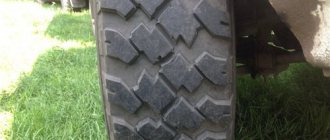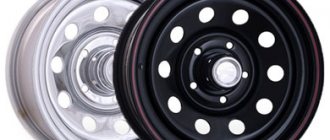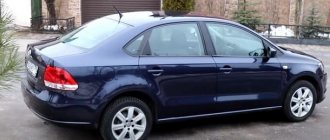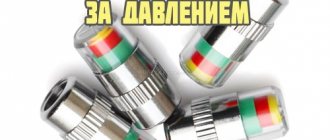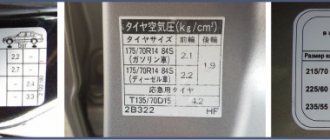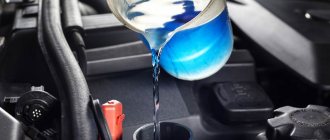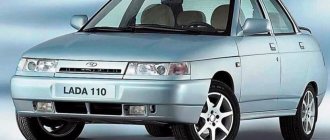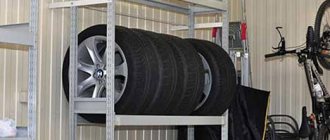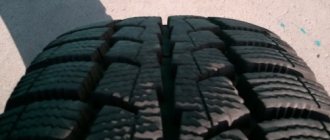Is the pressure in a car’s tires important, how to control it, how much to pump? Some car owners measure pressure by kicking the tire, while others resort to more careful measurements - with a pressure gauge.
Optimal pressure in the tires of a car will allow the driver to fully experience the safety and comfort of driving, while incorrect pressure will cause a lot of trouble.
How is tire pressure measured?
In our country and a number of others, pressure is usually measured in BARs (atmospheres). 1 atm.=1 kgf/cm2. To be extremely precise, 1 atmosphere is equal to 1.0133 bar, but such precision is not needed, it will be concealed by the readings of the pressure gauge, the error of which can reach 2%.
The standard that is common in the USA is PSI (pounds per square inch). To convert PSI to the atmospheres we are familiar with, this value must be divided by 14.5.
Below is a table of approximate ratios of values.
| Pressure Standards | |
| BAR | PSI |
| 1.8 | 26 |
| 1.9 | 28 |
| 2.0 | 29 |
| 2.1 | 30 |
| 2.2 | 32 |
| 2.3 | 33 |
| 2.4 | 35 |
| 2.5 | 36 |
| 2.6 | 38 |
| 2.7 | 39 |
| 2.8 | 41 |
| 2.9 | 42 |
| 3.0 | 44 |
Consideration of seasonal fluctuations
It is worth monitoring the tire inflation level more carefully during the off-season. Since an inflated wheel has the ability to change its performance depending on the air temperature. This pressure change rate is approximately 0.1 bar for every 10 degrees of temperature change. This is especially felt on large wheels with a volume of 60-65 liters.
If you have replaced summer tires with winter tires, they should be monitored with each subsequent drop in temperature, especially when frosts begin. So it’s worth checking the indicators if the air temperature drops below 10, 15 and 20 degrees. As the air temperature decreases, tire inflation rates drop, and as the ambient temperature rises, these values will increase.
When the tire is poorly inflated
If the tire is insufficiently inflated, the pressure of the wheel on the road is uneven, the quality (spot) of adhesion to the road surface decreases, and the tire itself is subject to premature wear. In addition, due to low rolling, fuel consumption increases.
Low tire pressure can be easily determined by its deformation, poor handling, and the car will pull towards the flat tire. In this case, there is a high probability of the frame breaking, damage to the cord threads, which will cause the tire to become unusable. To put it in the language of motorists, it will chew rubber.
What are the dangers of driving on improperly inflated tires?
Many novice motorists have the misconception that an overinflated tire is preferable to an underinflated one. An argument for this can be that on hypercars the tire pressure is usually higher than normal. In fact, any pressure deviation from normal values has an equally negative effect on the tires. Thus, with insufficient pressure, the contact area of the tread with the road surface increases, which causes greater wear at the edges.
Insufficient tire pressure is indicated by:
- increased fuel consumption by 10-20%;
- cornering with great effort;
- the car moves to the side when driving at speeds above 50 km/h.
When the normal pressure value is exceeded, the tread has a smaller contact area with the blade, therefore increased wear is observed in the center. Tire pressure that is too high is indicated by:
- loss of control when cornering;
- car jumps at speeds above 60 km/h (if the wheel hits a pothole or runs over a rock, the tire may be damaged);
- suspension operation in overloaded mode;
- increased noise in the cabin.
When the vehicle is at maximum load, do not over-inflate the wheels. Some car enthusiasts do this, mistakenly believing that the load needs to be compensated by pumping.
If the wheel is overinflated
An overinflated tire becomes too hard. It rolls easily, but like a flat tire, it has insufficient grip on the road, and this is fraught with accidents. The car will jump excessively, increasing the load on the body and suspension elements, and if it gets into a hole, the tire may simply burst.
When the machine is heavily loaded, it is not recommended to greatly increase the tire pressure, since all of the above risks can only intensify.
What is the best way to inflate a wheel?
The easiest way to do this is by specialists at a service station, who can specify the required pumping parameters.
If you are a car enthusiast who prefers to inflate the tires yourself. To do this you will need to complete the following steps:
- the car should be put on the handbrake;
- prepare a pump (manual, foot or electric) and a pressure gauge. Some automobile pumps are manufactured with a pressure gauge already built-in;
- unscrew the protective cap, connect the pump hose to the wheel and secure it;
- if a pressure gauge is not included in the design of your pump, you should check the pressure readings and, if necessary, pump up the wheels;
- After pumping is complete, you need to disconnect the pump and quickly put on the cap.
What should the pressure be?
The recommended tire pressure is usually determined by the vehicle manufacturer. There are a number of other factors, such as:
- vehicle's own weight;
- disc diameters;
- tire indices and markings.
You can find out what tire pressure should be in your tires from signs placed on the door pillar, gas filler flap or glove compartment. It is recommended to take measurements only when the tire is cold, since as it moves it heats up and the air inside expands, which gives a serious error in measurements.
For greater clarity, below is a table of tire pressures by car brand.
The specified values are recommended by car manufacturers.
METHODS OF MEASUREMENT
How to measure the tire pressure of VAZ cars? The measurement can be made using a special dial pressure gauge, but it should be noted that they may have an error of 0.2 atm. The pressure gauge can be either a separate device or as part of a wheel inflation pump.
We measure the pressure very simply:
- Reset the pressure gauge readings to zero;
- Remove the cap from the wheel spool (if there is one);
- Place the pressure gauge fitting on the nipple and press;
- We look at the arrow reading on the device.
It is recommended to take measurements at least once a month if the machine is used regularly. It is recommended to check tire inflation before leaving the garage after a long stay.
Pressure may increase when tires heat up. This often happens if the driver prefers a dynamic driving style with frequent and sharp braking. Therefore, measurements are taken on the car before the trip, when the wheels have not yet warmed up.
Table
| car brand | Dimensions | Pressure (front/rear) |
| vaz/lada | ||
| 2104 | 165/80 R13 | 1.6/2.1 |
| 175/70 R13 | 1.6/2.2 | |
| 2106 | 165/80 R13 | 1.6/1.9 |
| 175/70 R13 | 1.7/2.0 | |
| 165/70 R13 | 1.8/2.1 | |
| 2107 | 165/80 R13 | 1.6/1.9 |
| 175/70 R13 | 1.7/2.0 | |
| 2109/21099 | 165/70 R13 | 1.9/1.9 |
| 175/70 R13 | 1.9/1.9 | |
| 155/80 R13 | 1.9/1.9 | |
| 2110/2111/2112 | 175/70 R13 | 1.9/1.9 |
| 175/65 R14 | 1.8/1.8 | |
| 185/60 R14 | 1.8/1.8 | |
| 2114/2115 | 165/70 R13 | 1.9/1.9 |
| 175/70 R13 | 1.9/1.9 | |
| vesta | 185/65 R15 | 2.1/2.1 |
| 195/55 R16 | 2.1/2.1 | |
| granta | 175/70 R13 | 1.9/2.1 |
| 175/65 R14 | 2.0/2.2 | |
| Granta liftback | 175/65 R14 | 2.0/2.2 |
| 185/60 R14 | 2.0/2.2 | |
| 185/55 R15 | 2.0/2.2 | |
| viburnum (kalina) | 175/70 R13 | 1.9/1.9 |
| Kalina station wagon/hatchback | 185/60 R14 | 1.9/1.9 |
| priora | 175/70 R13 | 1.9/1.9 |
| 185/60 R14 | 1.9/1.9 | |
| Largus/Largus cross | 185/70 R14 | 2.4/2.6 |
| 185/65 R15 | 2.4/2.6 | |
| Niva | ||
| 2121/21213/21214/2131 | 175/80 R16 | 2.1/1.9 |
| 185/75 R16 | 2.1/2.0 | |
| gas | ||
| 3110/31105 | 195/65 R15 | 2.0/2.1 |
| 3307/3309 | 8.25R20 | 4.5/6.3 |
| 3308 | 12.00R18 | 3.5/4.5 |
| 53 | 8.25R20 | 4.0/6.3 |
| 66 | 8.00R18 | 2.8/2.8 |
| gazelle | ||
| 2705 (business) | 185/75 R16 | 3.0/3.0 |
| 3302 (cargo) | 185/75 R16 | 3.0/3.0 |
| next | 185/75 R16 | 3.6/2.9 |
| passenger | 185/75 R16 | 3.0/3.0 |
| sable | 215/65 R16 | 2.7/2.7 |
| sable 2752 | 185/75 R16 | 3.3/3.9 |
| Valdai | 215/75 R17 | 5.4/6.3 |
| lawn next | 185/75 R16 | 3.3/3.9 |
| zil | ||
| 130/131 | 9.00R20 | 4.5/6.0 |
| 5301 (bull) | 225/75 R16 | 5.0/6.0 |
| UAZ | ||
| 469 | 235/70R16 | 2.0/2.3 |
| patriot | 225/75R16 | 2.0/2.4 |
| 235/70R16 | 1.9/2.2 | |
| 245/70R16 | 1.8/2.1 | |
| 245/60R18 | 1.8/2.0 | |
| loaf | 225/75R16 | 2.0/2.3 |
| hunter | 225/75R16 | 2.0/2.3 |
| 235/70R16 | 2.1/2.4 | |
| KAMAZ | ||
| 4308 | 245/70R19.5 | 4.8/4.8 |
| 4310 | 245/70R19.5 | 4.8/4.8 |
| 43118 | 425/85R21 | 5.6/5.6 |
| other | ||
| maz | 235/75R17.5 | 6.5/7.3 |
| oka | 135/80R12 | 1.8/1.8 |
| Ural 4320 | 390/95R20 | 4.0/4.0 |
| groove 32053 | 245/70R19.5 | 5.6/4.6 |
| audi | ||
| a4 | 225/50R17 | 2.3/2.3 |
| 235/40R18 | 2.5/2.5 | |
| 245/45R17 | 2.2/2.1 | |
| q5 | 235/65R17 | 2.1/2.1 |
| 235/60R18 | 2.1/2.1 | |
| 235/55R19 | 2.1/2.1 | |
| 255/45R20 | 2.1/2.1 | |
| bmw | ||
| x5 | 235/65R17 | 2.2/2.2 |
| 255/55R18 | 2.2/2.2 | |
| 255/50R19 | 2.1/2.5 | |
| e39 | 225/60R15 | 2.0/2.2 |
| 205/65R15 | 2.2/2.4 | |
| 235/40R18 | 1.9/2.3 | |
| 265/35R18 | 2.3/2.7 | |
| 225/55R16 | 2.3/2.7 | |
| 235/45R17 | 2.5/2.7 | |
| x1 | 225/50R17 | 2.2/2.7 |
| 225/45R18 | 2.5/2.7 | |
| daewoo | ||
| matiz | 145/70R13 | 1.9/1.9 |
| 155/65R13 | 1.9/1.9 | |
| nexia | 175/70R13 | 2.0/2.1 |
| 185/60R14 | 2.2/2.4 | |
| dodge | ||
| caliber | 215/60R17 | 2.2/2.2 |
| 215/55R18 | 2.2/2.2 | |
| 225/45R19 | 2.2/2.2 | |
| caravan | 215/65R15 | 2.2/2.3 |
| ford | ||
| focus 3 | 195/65R15 | 2.1/2.1 |
| 205/55R16 | 2.1/2.1 | |
| 205/50R17 | 2.1/2.1 | |
| 225/40R18 | 2.1/2.1 | |
| kuga | 235/55R17 | 2.4/2.4 |
| 235/50R18 | 2.3/2.3 | |
| 235/45R19 | 2.3/2.3 | |
| mondeo 4 | 185/65R14 | 2.1/2.1 |
| 195/60R14 | 2.1/2.1 | |
| 205/55R15 | 2.1/2.1 | |
| transit | 195/70R15 | 3.4/2.7 |
| 195/65R16 | 3.7/4.0 | |
| 205/75R16 | 3.0/3.9 | |
| 215/75R16 | 3.0/4.0 | |
| focus 1 | 185/65R14 | 2.2/2.2 |
| 195/55R15 | 2.0/2.0 | |
| 205/50R16 | 2.2/2.2 | |
| 185/60R15 | 2.2/2.2 | |
| 215/40R17 | 2.2/2.2 | |
| focus 2 | 195/65R15 | 2.1/2.1 |
| 205/55R16 | 2.1/2.1 | |
| 225/40R18 | 2.1/2.1 | |
| fusion | 195/60R15 | 2.4/2.2 |
| 195/55R16 | 2.4/2.2 | |
| Explorer 5 | 235/75R15 | 2.1/2.4 |
| 225/70R15 | 2.1/2.4 | |
| fiat (fiat) | ||
| ducato | 195/70R15 | 4.1/4.5 |
| 205/70R15 | 4.1/4.5 | |
| 215/75R16 | 4.5/4.5 | |
| Jeep (jeep) | ||
| Grand Cherokee | 225/75R16 | 2.3/2.3 |
| 235/65R17 | 2.3/2.3 | |
| 235/70R16 | 2.3/2.3 | |
| 245/60R18 | 2.3/2.3 | |
| Hyundai | ||
| 78 | 175/60R14 | 2.3/2.3 |
| 175/50R15 | 2.3/2.3 | |
| ix35 | 215/70R16 | 2.3/2.3 |
| 225/60R17 | 2.3/2.3 | |
| accent | 155/80R13 | 2.1/2.1 |
| 185/60R14 | 2.1/2.1 | |
| 175/70R14 | 2.1/2.1 | |
| 195/55R15 | 2.1/2.1 | |
| Creta (Greta) | 215/65R16 | 2.3/2.3 |
| porter 2 (portrer) | 185/80R14 | 3.0/4.5 |
| solaris | 185/65R15 | 2.2/2.2 |
| 195/55R16 | 2.2/2.2 | |
| tucson | 215/65R16 | 2.1/2.1 |
| 235/60R16 | 2.1/2.1 | |
| getz | 155/80R13 | 2.1/2.1 |
| 175/65R14 | 2.1/2.1 | |
| 185/55R15 | 2.1/2.1 | |
| santa fe | 215/70R15 | 2.1/2.1 |
| 225/70R16 | 2.1/2.1 | |
| 235/70R16 | 2.1/2.1 | |
| 235/60R18 | 2.1/2.1 | |
| Chery | ||
| Cherie Tiggo (tiggo) | 225/65R17 | 2.3/2.3 |
| Chevrolet | ||
| aveo | 155/80R13 | 2.1/2.1 |
| 185/60R14 | 2.1/2.1 | |
| 195/65R15 | 2.5/2.5 | |
| 205/55R16 | 2.5/2.5 | |
| cobalt | 185/75R14 | 2.5/2.5 |
| 195/65R15 | 2.4/2.4 | |
| lanos | 175/70R13 | 2.2/2.2 |
| 185/60R14 | 2.2/2.2 | |
| Lacetti | 195/55R15 | 2.3/2.3 |
| Chevy Niva | 205/65R15 | 2.1/2.1 |
| 205/70R15 | 2.1/2.1 | |
| 215/65R16 | 2.2/2.2 | |
| captiva | 215/70R16 | 2.1/2.1 |
| 235/55R18 | 2.1/2.1 | |
| Cruze | 205/60R16 | 2.2/2.2 |
| 215/55R17 | 2.2/2.2 | |
| Kia | ||
| picanto | 155/70R13 | 2.1/2.1 |
| 165/60R14 | 2.1/2.1 | |
| 175/50R15 | 2.1/2.1 | |
| rio | 155/80R13 | 2.1/2.1 |
| 175/70R13 | 2.1/2.1 | |
| 175/70R14 | 2.1/2.1 | |
| 185/65R15 | 2.1/2.1 | |
| 195/55R15 | 2.2/2.2 | |
| 195/55R16 | 2.2/2.2 | |
| seed | 185/65R15 | 2.2/2.2 |
| 225/45R17 | 2.2/2.2 | |
| sorento | 225/75R16 | 2.5/2.5 |
| 245/70R16 | 2.5/2.5 | |
| 235/65R17 | 2.2/2.2 | |
| 235/60R18 | 2.3/2.3 | |
| sportage (3, 4, 2016) | 205/70R15 | 1.8/1.8 |
| 215/65R16 | 2.1/2.1 | |
| 235/60R16 | 2.1/2.1 | |
| 215/70R16 | 2.3/2.3 | |
| 225/60R17 | 2.3/2.3 | |
| cerato | 195/60R15 | 2.1/2.1 |
| 205/50R16 | 2.1/2.1 | |
| Lexus (Lexus) | ||
| 570 | 285/60R18 | 2.3/2.6 |
| 285/50R20 | 2.3/2.6 | |
| rx350 | 225/60R17 | 2.1/2.1 |
| 235/55R18 | 2.2/2.2 | |
| 235/60R18 | 2.3/2.3 | |
| 235/55R19 | 2.3/2.3 | |
| Mitsubishi (Mitsubishi) | ||
| Lancer 10 (9) | 195/60R15 | 2.2/2.1 |
| 195/50R16 | 2.3/2.1 | |
| 235/45R17 | 2.2/1.9 | |
| 205/60R16 | 2.2/2.2 | |
| 215/45R18 | 2.2/2.2 | |
| Outlander | 215/55R16 | 2.1/2.0 |
| 215/70R16 | 2.2/2.2 | |
| 215/55R17 | 2.2/2.2 | |
| 225/55R18 | 2.2/2.2 | |
| Pajero 4 (pajero) | 265/65R17 | 2.2/2.4 |
| 265/60R18 | 2.2/2.4 | |
| Mercedes (Mercedes) | ||
| sprinter | 225/70R15 | 2.8/4.0 |
| Mazda (Mazda) | ||
| 3 | 195/65R15 | 2.2/2.2 |
| 205/60R15 | 2.5/2.3 | |
| 205/55R16 | 2.2/2.2 | |
| 6 | 195/65R15 | 2.2/2.2 |
| 195/65R16 | 2.2/2.2 | |
| 205/55R16 | 2.2/2.2 | |
| 215/45R17 | 2.2/2.2 | |
| 215/50R17 | 2.2/2.2 | |
| 215/45R18 | 2.2/2.2 | |
| cx 5 | 225/65R17 | 2.3/2.3 |
| 225/55R19 | 2.5/2.5 | |
| cx 7 | 235/60R18 | 2.2/2.2 |
| 235/55R19 | 2.2/2.2 | |
| Nissan | ||
| Qashqai | 215/65R16 | 2.3/2.3 |
| 215/60R17 | 2.3/2.3 | |
| 215/55R18 | 2.3/2.3 | |
| almera/classic | 185/65R15 | 2.0/2.0 |
| 195/60R15 | 2.0/2.0 | |
| 195/55R16 | 2.0/2.0 | |
| laptop (note) | 185/65R15 | 2.3/2.1 |
| 175/65R15 | 2.3/2.1 | |
| 185/55R16 | 2.3/2.1 | |
| teana | 205/65R16 | 2.2/2.0 |
| 215/55R17 | 2.2/2.0 | |
| tiida | 185/65R15 | 2.3/2.1 |
| 195/65R16 | 2.3/2.1 | |
| x trail (x-trail) | 215/70R15 | 2.2/2.2 |
| 215/65R16 | 2.2/2.2 | |
| x trail t31 | 215/65R16 | 2.3/2.1 |
| 225/60R17 | 2.3/2.1 | |
| 225/55R18 | 2.3/2.1 | |
| Opel (Opel) | ||
| astra jh (astra) | 225/55R17 | 2.2/2.2 |
| 235/55R17 | 2.2/2.2 | |
| 235/50R18 | 2.2/2.2 | |
| 245/45R18 | 2.2/2.2 | |
| 235/45R19 | 2.2/2.2 | |
| 245/40R20 | 2.2/2.2 | |
| corsa | 185/70R14 | 2.0/1.8 |
| 185/65R15 | 2.0/1.8 | |
| 195/60R15 | 2.0/1.8 | |
| 195/55R16 | 2.0/1.8 | |
| 215/45R17 | 2.0/1.8 | |
| Peugeot | ||
| 206 | 165/70R13 | 2.2/2.2 |
| 175/65R14 | 2.4/2.4 | |
| 185/55R15 | 2.3/2.3 | |
| 205/45R16 | 2.3/2.3 | |
| 307 | 195/65R15 | 2.3/2.3 |
| 205/55R16 | 2.5/2.5 | |
| 205/50R17 | 2.5/2.5 | |
| 308 | 195/65R15 | 2.3/2.3 |
| 205/55R16 | 2.4/2.4 | |
| 215/55R16 | 2.5/2.5 | |
| 225/45R17 | 2.5/2.5 | |
| 225/40R18 | 2.7/2.7 | |
| boxer | 195/70R15 | 4.1/4.5 |
| 205/70R15 | 4.1/4.5 | |
| 205/75R16 | 4.5/4.7 | |
| 215/75R16 | 4.5/4.7 | |
| 215/70R15 | 4.1/4.1 | |
| 215/70R16 | 5.0/5.0 | |
| 225/75R16 | 4.6/5.1 | |
| partner | 165/70R14 | 2.4/2.6 |
| 175/65R14 | 2.6/2.6 | |
| 185/65R15 | 2.0/2.2 | |
| 195/65R15 | 2.3/2.3 | |
| Renault (Renault) | ||
| sandero | 185/65R15 | 2.2/2.2 |
| 195/55R16 | 2.2/2.2 | |
| simbol | 175/70R13 | 1.9/2.1 |
| 175/65R14 | 1.9/2.1 | |
| 185/60R14 | 2.2/2.4 | |
| 185/55R15 | 2.3/2.5 | |
| duster | 215/65R16 | 2.0/2.0 |
| logan | 165/80R14 | 2.0/2.0 |
| 185/65R15 | 2.1/2.0 | |
| Megane 2 | 195/65R15 | 2.4/2.0 |
| 205/55R16 | 2.2/2.0 | |
| 205/50R17 | 2.2/2.0 | |
| 205/55R17 | 2.2/2.0 | |
| SsangYong | ||
| Kyron | 225/75R16 | 2.3/2.3 |
| 235/75R16 | 2.1/2.1 | |
| 255/60R18 | 2.1/2.1 | |
| Subaru (subaru) | ||
| outback | 185/70R14 | 2.2/2.1 |
| 195/60R15 | 2.2/2.1 | |
| 205/50R16 | 2.3/2.2 | |
| 215/60R16 | 2.0/2.0 | |
| 205/55R16 | 2.2/2.2 | |
| 215/45R17 | 2.2/2.2 | |
| 215/50R17 | 2.5/2.4 | |
| 215/55R17 | 2.2/2.0 | |
| 225/60R17 | 2.3/2.2 | |
| Suzuki | ||
| grand vitara | 195/80R15 | 1.8/1.8 |
| 205/75R15 | 1.8/1.8 | |
| 215/65R16 | 1.8/2.1 | |
| 235/60R16 | 1.8/1.8 | |
| 215/70R15 | 2.2/2.2 | |
| 225/65R17 | 2.2/2.2 | |
| Toyota | ||
| rav4 (rav 4) | 215/70R16 | 2.0/2.0 |
| 235/60R16 | 2.0/2.0 | |
| 225/65R17 | 2.2/2.2 | |
| 235/55R18 | 2.2/2.2 | |
| land cruiser prado | 215/80R16 | 2.2/2.2 |
| land cruiser prado | 265/70R16 | 2.6/2.4 |
| 100, 120, 150, 200 | 225/70R17 | 2.4/2.4 |
| 265/65R17 | 2.4/2.4 | |
| auris | 195/65R15 | 2.2/2.2 |
| 205/55R16 | 2.3/2.3 | |
| 225/45R17 | 2.3/2.3 | |
| camry | 205/65R15 | 2.3/2.3 |
| 215/60R16 | 2.1/2.1 | |
| corolla | 155/80R13 | 2.1/2.0 |
| 165/70R14 | 2.2/2.2 | |
| 175/65R14 | 2.2/2.2 | |
| 185/65R14 | 2.2/2.2 | |
| 185/55R15 | 2.2/2.2 | |
| 195/55R15 | 2.2/2.2 | |
| Volkswagen (volkswagen) | ||
| b5, b6 | 195/65R15 | 1.9/1.9 |
| 205/60R15 | 2.4/2.2 | |
| 205/55R16 | 2.0/1.9 | |
| 225/45R17 | 2.3/2.1 | |
| polo sedan (polo) | 195/55R15 | 2.0/1.9 |
| 205/45R16 | 2.3/2.1 | |
| tiguan | 215/65R16 | 2.2/2.2 |
| 215/60R17 | 2.2/2.2 | |
| 235/55R17 | 2.2/2.2 | |
| 235/50R18 | 2.2/2.2 | |
| Tuareg (Tuareg) | 235/65R17 | 2.3/2.5 |
| 255/60R17 | 2.3/2.5 | |
| 255/55R18 | 2.3/2.5 | |
| 265/50R19 | 2.3/2.5 | |
| 275/45R20 | 2.3/2.5 | |
| 275/40R21 | 2.3/2.5 | |
| Volvo (Volvo) | ||
| xc90 | 235/65R17 | 2.2/2.7 |
| 235/60R18 | 2.7/2.7 | |
| 255/50R19 | 2.4/2.4 | |
| 255/45R20 | 2.4/2.4 | |
| Scoda (Skoda) | ||
| Octavia A5 (octavia) | 195/65R15 | 2.2/2.2 |
| 205/60R15 | 2.1/2.2 | |
| 205/55R16 | 2.2/2.2 | |
| 225/45R17 | 2.2/2.2 | |
| Octavia A7 | 195/65R15 | 2.2/2.3 |
| 205/55R16 | 2.1/2.1 | |
| 205/50R17 | 2.1/2.1 | |
| 225/45R17 | 2.1/2.1 | |
| 225/40R18 | 2.0/2.1 | |
| rapid | 185/60R15 | 2.2/2.4 |
| 195/55R15 | 2.2/2.4 | |
| 215/45R16 | 2.2/2.3 | |
| 215/40R17 | 2.2/2.3 | |
| Honda | ||
| CRV | 205/70R15 | 1.8/1.8 |
| 205/65R16 | 1.8/1.8 | |
| 215/65R16 | 2.1/2.0 | |
Winter tire pressure
The optimal pressure in car tires in winter and summer may differ slightly. In winter, wheels can be inflated 0.2-0.3 atmospheres more than in summer. This is due to the fact that when the air heats up, the pressure inside the wheel increases, and when it cools, it decreases. This means that an equal volume of air in winter and summer will have different values.
| Size | In summer | in winter |
| R13 | 1.9 | 2.1 |
| R14 | 2.0 | 2.2 |
| R15 | 2.0 | 2.2 |
| R16 | 2.0 | 2.2 |
| R17 | 2.2 | 2.4 |
Is it worth it or not to inflate your tires with nitrogen?
Recently, almost all tire stations have introduced the expensive service of filling tires with nitrogen. Its popularity is due to a number of the following opinions:
- Thanks to nitrogen, the pressure in the tires remains unchanged when they heat up.
- The service life of rubber increases (it practically does not “age”, since nitrogen is much cleaner than air).
- Steel wheel rims are not subject to corrosion.
- The possibility of tire rupture is completely eliminated, since nitrogen is a non-flammable gas.
However, these statements are nothing more than another advertising ploy by marketers. After all, the nitrogen content in the air is about 80%, and it is unlikely that anything can change for the better if the nitrogen content inside the tires increases by 10-15%.
In this case, you should not spend extra money and inflate the wheels with expensive nitrogen, since there will be no additional benefit, as well as harm, from this procedure.
Many novice car enthusiasts, after purchasing a vehicle, often have a question: what should be the pressure in tires with a radius of R15? Lack of proper experience and professional knowledge in operating a car very often becomes the reason for the owner’s elementary forgetfulness to check the pressure in the car’s tires.
As a rule, this is considered a serious error and directly affects the controllability of the vehicle, which can lead to a serious emergency situation on the road and dire consequences. But let's talk about everything in order.
Pressure monitoring using instruments
Most drivers do not want to check their pressure often. The reasons are different: dirty wheels, the “painstaking” procedure - unscrew the cap and measure with a pressure gauge. Indicator caps were invented for such “lazy people”; they display tire pressure.
They are mounted directly on the valve, everything is already set to a pressure of 1.8 - 4 atmospheres. The devices are universal and can be installed on any valves of tubes and tubeless tires of motorcycles, cars, trucks, buses and other vehicles.
The color pressure sensor is installed in place of the standard cap. The condition of the tire is determined by the rod with sectors of different colors. A green mark means everything is normal. The yellow sector will report a pressure drop of 0.3 atmospheres below normal.
At this pressure, movement is permissible at a speed not exceeding 50 km/h. The red sector signal means that the tire pressure has dropped to an unacceptable value - by 0.7 atmospheres or more, this requires immediate tire inflation.
The use of measuring devices is most widespread on cars of the middle and executive classes. They are equipped with light and sound indications and display readings on the monitor, so the driver will immediately know about any changes. We wrote in more detail about such control systems in this article.
Sealing mixtures and armor
In case of “catching a nail”, there are various mixtures. You just need to pump them into the wheel in advance, after which you can safely drive to the tire shop. Tires have long been invented that can continue moving, even if there is no air in them.
These are the so-called hard side tires. On such tires, if there is a puncture or valve failure, you can drive at speeds of up to 80 km/h. The car maintains maneuverability and stability in turns. These tires are called Run Flat.
Armored limousines are equipped with wheels equipped with special rims and inserts-bandages consisting of high-strength metal or plastic. Even if the car explodes or the tires are deformed, they can travel a very significant distance at a speed of 60-80 km/h. Of course, such wheels are an expensive pleasure.
Let's sum it up
Practice shows that during the operation of any, even the most famous tires, from time to time everyone has to visit a “tire repair shop” to perform inflation.
In order not to be left on the side of the road with a broken or flat tire, you should remember the golden rules:
- The spare wheel must be in good condition, ready to replace a broken one.
- There should be a compressor or pump in the trunk to inflate the tires.
What else is worth reading
Wheel rim bolt pattern
The suspension device, how it works and what it consists of
Car clutch device Clutch as an important element of the transmission
High pressure fuel pump design
Replacing a flat tire
In a situation where rolling does not help a flat tire and it continues to go flat at varying intervals. You should make a replacement using the spare tire and contact a car service for a tire fitting service. After all, the most difficult situation on the road can arise precisely when the car’s wheels have different degrees of inflation.
With such indicators, fuel consumption increases significantly. The car begins to roll towards the least inflated wheel. Which leads to its rapid and uneven wear. Other vehicle systems may also not function properly.
And your ride will become very uncomfortable and even dangerous.
